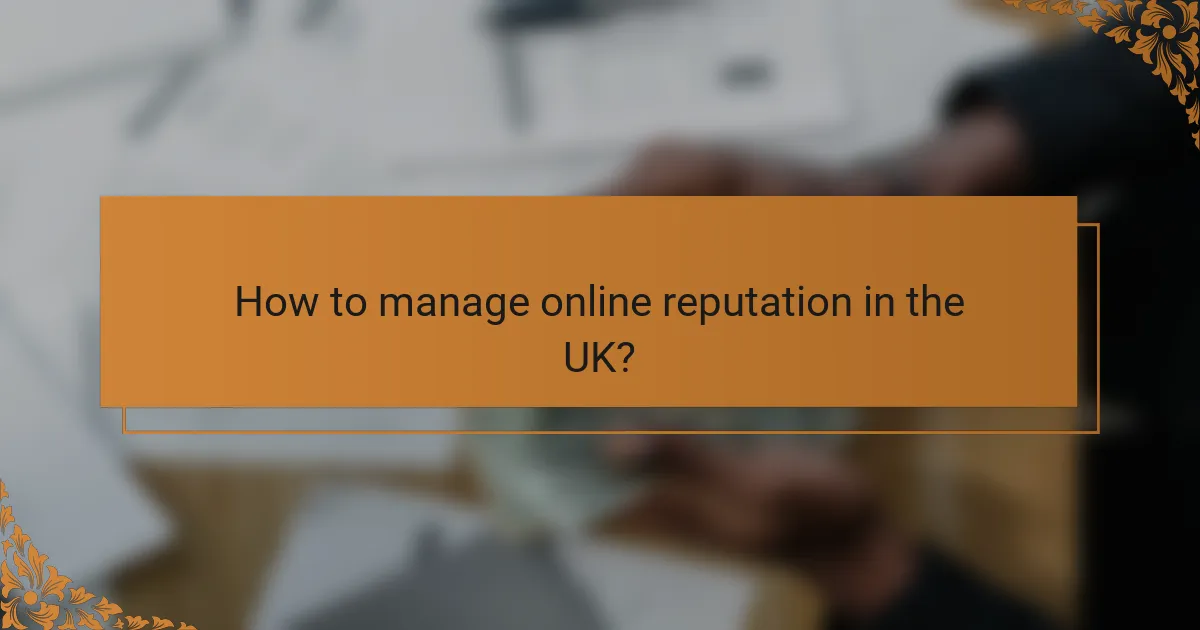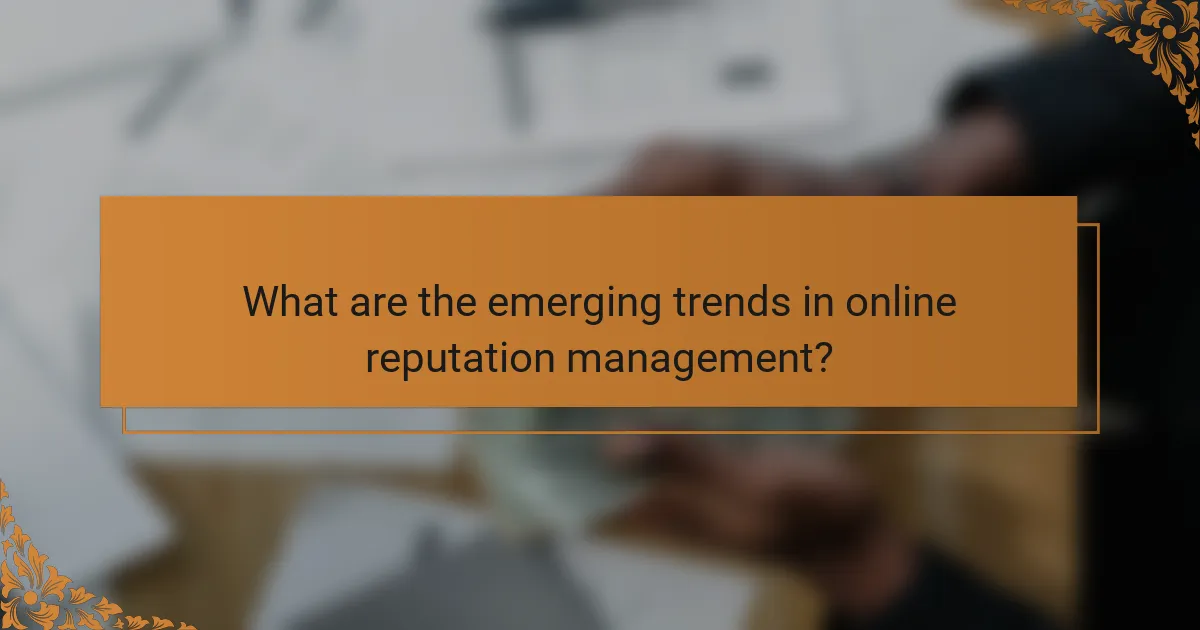Online reputation management is essential for businesses looking to maintain a positive image in today’s digital landscape. By actively monitoring brand mentions across social media and other online platforms, companies can gain valuable insights into public perception and address any issues that arise. Utilizing social listening tools and automated alerts enables timely engagement with customer feedback, ensuring that brands can effectively manage their reputation and respond to potential crises.

How to manage online reputation in the UK?
Managing online reputation in the UK involves actively monitoring brand mentions, engaging with customer feedback, and implementing effective crisis management strategies. By focusing on these areas, businesses can maintain a positive image and address any potential issues promptly.
Utilize brand monitoring tools
Brand monitoring tools help track mentions of your business across various online platforms, including social media, blogs, and review sites. Tools like Google Alerts, Mention, and Brand24 can provide real-time notifications, allowing you to respond quickly to both positive and negative feedback.
When selecting a tool, consider factors such as ease of use, coverage of platforms, and pricing. Many tools offer free trials, so take advantage of these to find the best fit for your needs.
Engage with customer feedback
Engaging with customer feedback is crucial for building trust and loyalty. Responding to reviews and comments, whether positive or negative, shows that you value customer opinions. Aim to reply promptly, ideally within 24 hours, to demonstrate your commitment to customer satisfaction.
For negative feedback, address the issue directly and offer solutions. This approach can turn a dissatisfied customer into a loyal advocate. Consider creating a dedicated team for managing customer interactions to ensure consistency and professionalism.
Implement crisis management strategies
Having a crisis management strategy in place is essential for mitigating damage to your online reputation. Start by identifying potential risks and developing a response plan that includes clear communication guidelines and designated spokespersons.
In the event of a crisis, act quickly to acknowledge the issue and provide updates as necessary. Transparency is key; keep your audience informed while working towards a resolution. Regularly review and update your crisis management plan to adapt to new challenges and maintain its effectiveness.

What are brand mentions and why are they important?
Brand mentions refer to instances where a company’s name, products, or services are referenced online, whether in social media, blogs, or news articles. They are crucial for understanding public perception and can significantly influence a brand’s reputation and visibility.
Definition of brand mentions
Brand mentions occur whenever a user mentions a brand name in any online content, including social media posts, reviews, or articles. These mentions can be direct, where the brand is explicitly named, or indirect, where the brand is implied through context or related keywords.
Monitoring brand mentions helps businesses track their online presence and gauge customer sentiment. Tools like social media listening platforms can automate this process, providing insights into how often and in what context a brand is discussed.
Impact on brand perception
Brand mentions can significantly shape how consumers view a company. Positive mentions can enhance credibility and trust, while negative mentions can damage reputation and deter potential customers. For example, a single negative review on a popular platform can lead to a noticeable decline in sales.
To manage brand perception effectively, companies should actively engage with both positive and negative mentions. Responding to customer feedback, whether praise or criticism, demonstrates that a brand values its audience and is committed to improvement. Regularly analyzing mention trends can also help identify potential issues before they escalate.

How to track brand mentions effectively?
To track brand mentions effectively, utilize a combination of social listening tools and automated alerts. These methods help you monitor conversations about your brand across various platforms, allowing for timely responses and reputation management.
Use social listening tools
Social listening tools are essential for monitoring brand mentions across social media and online platforms. They analyze conversations and sentiments related to your brand, providing insights into customer opinions and trends. Popular tools include Hootsuite, Brandwatch, and Sprout Social.
When selecting a tool, consider factors like coverage, ease of use, and pricing. Many tools offer tiered pricing, which can range from free basic versions to more comprehensive paid plans. Choose one that fits your budget while meeting your tracking needs.
Set up Google Alerts
Google Alerts is a free and straightforward way to track brand mentions on the web. By setting up alerts for your brand name, you receive email notifications whenever new content is published that includes your specified keywords. This allows you to stay updated on relevant discussions and articles.
To set up Google Alerts, simply enter your brand name in the alert creation form, adjust the settings for frequency and sources, and save. Regularly review your alerts to ensure they remain relevant and adjust keywords as necessary to capture all pertinent mentions.

What role does social media play in reputation management?
Social media is a critical component of reputation management, as it shapes public perception and allows brands to engage directly with their audience. Effective management of social media presence can enhance a brand’s image and mitigate negative feedback.
Influence of social media on public perception
Social media platforms serve as a primary source of information for consumers, influencing their opinions and decisions. Positive mentions and interactions can enhance a brand’s reputation, while negative comments can quickly spread and damage credibility. Brands must monitor their social media presence to understand how they are perceived and respond appropriately.
For example, a single negative review on a popular platform can lead to a significant decline in customer trust. Conversely, a well-handled customer service interaction on social media can turn a dissatisfied customer into a loyal advocate.
Strategies for positive engagement
To foster a positive reputation on social media, brands should actively engage with their audience by responding to comments and messages promptly. Regularly sharing valuable content that resonates with the target audience can also enhance brand perception. Consistency in tone and messaging reinforces brand identity and builds trust.
Additionally, brands should consider implementing a social media policy that outlines best practices for engagement and response. This can help avoid common pitfalls, such as responding defensively to criticism or ignoring negative feedback altogether. Regularly analyzing engagement metrics can provide insights into what strategies are most effective.

What are the best practices for responding to negative mentions?
Effective responses to negative mentions involve promptness and professionalism. Addressing concerns quickly can mitigate damage and demonstrate your commitment to customer satisfaction.
Timely and professional responses
Responding to negative mentions in a timely manner is crucial. Aim to reply within a few hours to show that you value customer feedback and are attentive to their concerns. A professional tone is essential; maintain respect and empathy, regardless of the comment’s nature.
Consider acknowledging the issue publicly, then offer to resolve it privately. This approach not only addresses the individual’s concern but also showcases your commitment to customer care to others who may be watching.
Turning negatives into positives
Transforming negative feedback into a positive experience can enhance your brand’s reputation. Use the opportunity to demonstrate excellent customer service by resolving the issue effectively and following up with the customer.
For example, if a customer complains about a product, offer a replacement or refund. Highlighting your willingness to make things right can turn a dissatisfied customer into a loyal advocate. Additionally, share these success stories on your social media platforms to showcase your proactive approach.

How to measure the success of reputation management efforts?
Measuring the success of reputation management efforts involves tracking various metrics that reflect public perception and brand sentiment. Key indicators include brand mentions, social media engagement, and overall sentiment analysis.
Key performance indicators (KPIs)
Key performance indicators (KPIs) for reputation management help assess how well your brand is perceived online. Common KPIs include brand mention volume, sentiment score, share of voice, and customer engagement rates. For instance, a significant increase in positive mentions can indicate successful reputation management.
When selecting KPIs, focus on those that align with your specific goals. If your aim is to improve customer trust, monitor sentiment scores and customer feedback closely. Setting benchmarks based on past performance can also provide context for evaluating progress.
Tools for tracking reputation metrics
Various tools are available to track reputation metrics effectively. Social media monitoring platforms like Hootsuite and Brandwatch can help you analyze brand mentions across different channels. These tools often provide sentiment analysis, allowing you to gauge public perception in real-time.
Additionally, Google Alerts can be a simple yet effective way to monitor online mentions of your brand. Setting up alerts for specific keywords related to your brand can help you stay informed about discussions and trends. Combining multiple tools can provide a comprehensive view of your reputation landscape.

What are the emerging trends in online reputation management?
Emerging trends in online reputation management (ORM) focus on leveraging technology and data analytics to monitor and enhance brand perception. Key developments include the use of artificial intelligence, real-time tracking of brand mentions, and the integration of social media insights into reputation strategies.
AI-driven reputation analysis
AI-driven reputation analysis utilizes machine learning algorithms to assess brand sentiment across various online platforms. This technology can process vast amounts of data quickly, identifying patterns and trends that may not be immediately visible to human analysts.
For effective AI-driven analysis, businesses should consider integrating tools that monitor social media, review sites, and news outlets. These tools can provide insights into customer sentiment, allowing brands to respond proactively to negative mentions and capitalize on positive feedback.
When implementing AI solutions, ensure that the chosen tools align with your specific needs and budget. Look for platforms that offer customizable dashboards and reporting features to track key performance indicators effectively. Avoid relying solely on automated responses; human oversight is crucial for nuanced engagement with your audience.